
Pope Innocent X, born Giovanni Battista Pamphilj, was head of the Catholic Church and ruler of the Papal States from 15 September 1644 to his death, in January 1655.
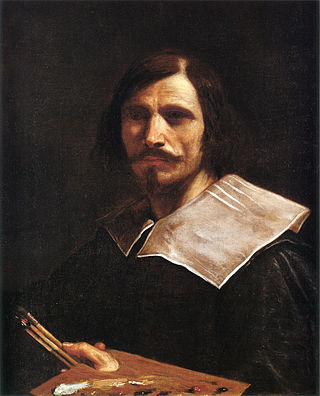
Giovanni Francesco Barbieri, better known as (il) Guercino, was an Italian Baroque painter and draftsman from Cento in the Emilia region, who was active in Rome and Bologna. The vigorous naturalism of his early manner contrasts with the classical equilibrium of his later works. His many drawings are noted for their luminosity and lively style.

Guido Reni was an Italian painter of the Baroque period, although his works showed a classical manner, similar to Simon Vouet, Nicolas Poussin, and Philippe de Champaigne. He painted primarily religious works, but also mythological and allegorical subjects. Active in Rome, Naples, and his native Bologna, he became the dominant figure in the Bolognese School that emerged under the influence of the Carracci.

Fortuna is the goddess of fortune and the personification of luck in Roman religion who, largely thanks to the Late Antique author Boethius, remained popular through the Middle Ages until at least the Renaissance. The blindfolded depiction of her is still an important figure in many aspects of today's Italian culture, where the dichotomy fortuna / sfortuna plays a prominent role in everyday social life, also represented by the very common refrain "La [dea] fortuna è cieca".
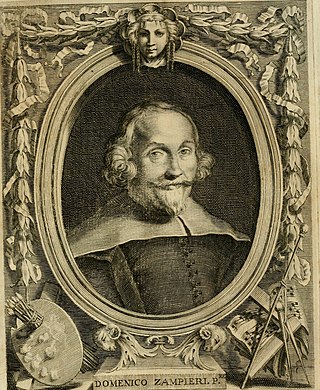
Domenico Zampieri, known by the diminutive Domenichino after his shortness, was an Italian Baroque painter of the Bolognese School of painters.
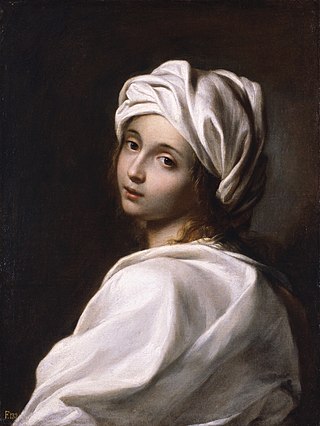
Beatrice Cenci was a Roman noblewoman imprisoned by her father, who repeatedly raped her. To escape the abuse and get away from the house, she killed him. The story of the murder and what led up to it shocked Europe. Despite outpourings of public sympathy, Beatrice Cenci was beheaded in 1599 after a lurid murder trial in Rome that gave rise to an enduring legend about her.

Giovanni Lanfranco was an Italian painter of the Baroque period.

The Denial of Saint Peter(La Negazione di Pietro) is a painting finished around 1610 by the Italian painter Caravaggio. It depicts Peter denying Jesus after Jesus was arrested. The painting is housed in the Metropolitan Museum of Art in New York City.

Giulio Aristide Sartorio was an Italian painter and film director from Rome.

Palazzo Montecitorio is a palace in Rome and the seat of the Chamber of Deputies, the lower house of the Italian Parliament.

Massimo Stanzione was an Italian Baroque painter, mainly active in Naples, where he and his rival Jusepe de Ribera dominated the painting scene for several decades. He was primarily a painter of altarpieces, working in both oils and fresco. His main subject matter was biblical scenes. He also painted portraits and mythological subjects. He had many pupils and followers as his rich color and idealized naturalism had a large influence on other local artists, such as Francesco Solimena. In 1621 Pope Gregory XV gave him the title of Knight of the Golden Spur and Pope Urban VIII made him a knight of St. John around 1624 and a knight of the Order of Christ in 1627. From then on, he liked to sign his works as "EQUES MAXIMUS".

Michele Desubleo (1601–1676), also called Michele Fiammingo (Flemish) or Michele di Giovanni de Sobleau, was a Flemish painter active in Central and North Italy during the Baroque era.

Ginevra Cantofoli (1618–1672) was an Italian painter. She was active in Bologna during the Baroque period.

The Galleria Spada is a museum in Rome, which is housed in the Palazzo Spada on Piazza Capo di Ferro. The palazzo is also famous for its façade and for the forced perspective gallery by Francesco Borromini.
The Sack of Rome is a 1920 Italian silent historical film directed by Enrico Guazzoni and Giulio Aristide Sartorio. The film portrays the 1527 Sack of Rome.

Flaminio is the 1st quartiere of the Italian capital Rome. Identified by the initials Q. I, it belongs to the Municipio II and has 13,018 inhabitants and an area of 1.1877 km². The name is derived from the Via Flaminia.
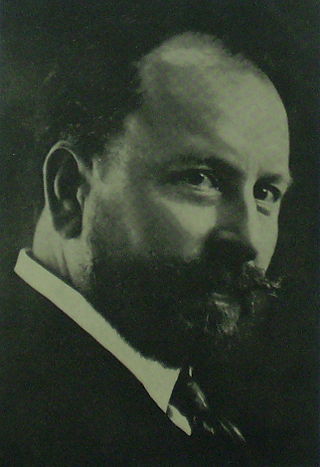
Carlos Pablo Ripamonte was an Argentine painter.
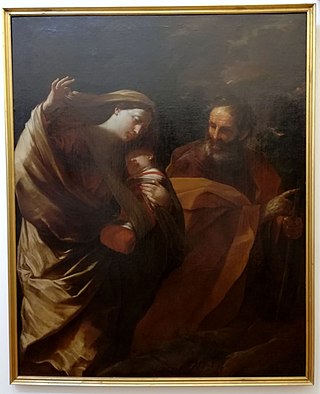
The Flight into Egypt is a c. 1622 oil on canvas painting by Guido Reni in the Girolamini, Naples in Naples.

Saint Sebastian is a c. 1615 oil on canvas painting by Guido Reni, now in the Capitoline Museums in Rome. It is one of three similar treatments of the subject produced by the artist - the others are now in the Palazzo Rosso in Genoa (c.1615) and another in the Rhode Island School of Design Museum in Providence.

The Rape of Lucretia may refer to several variations on the same theme which are usually attributed to either Felice Ficherelli or Guido Cagnacci and dated to the late 1630s or about 1640.




















